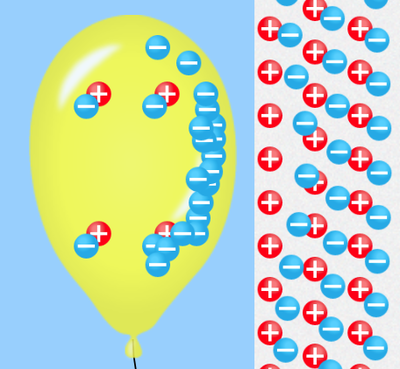Difference between revisions of "Electrostatic Induction"
| Line 9: | Line 9: | ||
To learn more about [[Electrostatic Induction]] click on each of the picture below for a PHET simulation and once the balloon is [[Electrical Charge|charged]] place it near the [[Neutral (Physics)|neutral]] wall to see the '''induced''' [[Electrical Charge|charge]]. | To learn more about [[Electrostatic Induction]] click on each of the picture below for a PHET simulation and once the balloon is [[Electrical Charge|charged]] place it near the [[Neutral (Physics)|neutral]] wall to see the '''induced''' [[Electrical Charge|charge]]. | ||
{| class="wikitable" | {| class="wikitable" | ||
| − | |[[File:PhetStatic2.png|centre| | + | |[[File:PhetStatic2.png|centre|400px|link=https://phet.colorado.edu/sims/html/balloons-and-static-electricity/latest/balloons-and-static-electricity_en.html]] |
| + | |- | ||
| + | | style="height:20px; width:200px; text-align:center;" |In this [[diagram]] the balloon is [[Electrical Charge|charged]] with extra [[electron]]s which causes the [[electron]]s in the [[Neutral Charge|neutral]] wall to be [[repel]]led. | ||
|} | |} | ||
| Line 22: | Line 24: | ||
To learn more about [[Electrostatic Induction]] click on each of the picture below for a PHET simulation and once the balloon is [[Electrical Charge|charged]] place it near the [[Neutral (Physics)|neutral]] wall to see the '''induced''' [[Electrical Charge|charge]]. | To learn more about [[Electrostatic Induction]] click on each of the picture below for a PHET simulation and once the balloon is [[Electrical Charge|charged]] place it near the [[Neutral (Physics)|neutral]] wall to see the '''induced''' [[Electrical Charge|charge]]. | ||
{| class="wikitable" | {| class="wikitable" | ||
| − | |[[File:PhetStatic2.png|centre| | + | |[[File:PhetStatic2.png|centre|400px|link=https://phet.colorado.edu/sims/html/balloons-and-static-electricity/latest/balloons-and-static-electricity_en.html]] |
| + | |- | ||
| + | | style="height:20px; width:200px; text-align:center;" |In this [[diagram]] the balloon is [[Electrical Charge|charged]] with extra [[electron]]s which causes the [[electron]]s in the [[Neutral Charge|neutral]] wall to be [[repel]]led. | ||
|} | |} | ||
Revision as of 11:51, 3 March 2019
Contents
Key Stage 3
Meaning
Electrostatic induction is when a charged object induces a charge in a neutral object.
About Electrostatic Induction
- Neutral objects are made of an equal number of positively charged protons and negatively charged electrons.
- The electrons around an atom can move, so when a charged object is placed near a neutral the electrons can move towards or away from that charged object. This is electrostatic induction.
To learn more about Electrostatic Induction click on each of the picture below for a PHET simulation and once the balloon is charged place it near the neutral wall to see the induced charge.
| In this diagram the balloon is charged with extra electrons which causes the electrons in the neutral wall to be repelled. |
Key Stage 4
Meaning
Electrostatic induction is when a charged object induces a charge in a neutral object.
About Electrostatic Induction
- Neutral objects are made of an equal number of positively charged protons and negatively charged electrons.
- The electrons around an atom can move, so when a charged object is placed near a neutral the electrons can move towards or away from that charged object. This is electrostatic induction.
To learn more about Electrostatic Induction click on each of the picture below for a PHET simulation and once the balloon is charged place it near the neutral wall to see the induced charge.
| In this diagram the balloon is charged with extra electrons which causes the electrons in the neutral wall to be repelled. |
